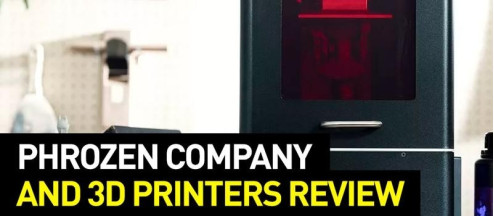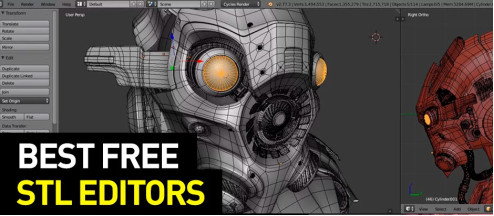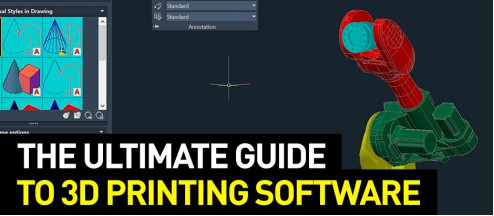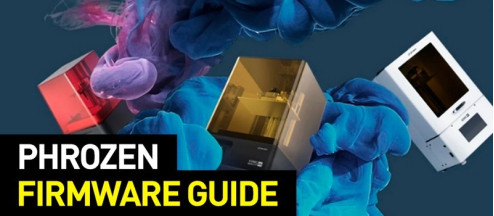Phrozen Shuffle 4K 3D Printer Review

In our new review, we talk about the Phrozen Shuffle 4K 3D printer using LCD technology. This is one of the few 3940 x 2160 pixel LCD printers on the market. The use of such equipment provides an XY resolution of 31 microns.
Read the article to learn about the capabilities and features of the printer for jewelers and designers Phrozen Shuffle 4K.
Video
About the company
The Taiwanese company Phrozen appeared on the market rather recently but has already managed to make quite a number of fans following the updates of the lineup. The founders of Phrozen are engineers who are passionate about additive manufacturing. They gathered to create a startup but did it in an unusual way. According to Phrozen, they first formed a large community in Southeast Asia, whose members shared their experience in printing with resins.

Source: facebook.com
In 2016, sales of the first Phrozen One DLP 3D Printer started. As its name suggests, the device used DLP technology. In the next year, developers abandoned the idea to build on the product line of DLP devices. Instead, they created the relatively inexpensive Phrozen Make LCD printer, which provides high-accuracy printing. The Taiwanese manufacturer did not seek funds for the production from investors. So, in April 2017, a fundraising campaign on Kickstarter was announced.
Obviously, the Phrozen brand already had such an impeccable reputation that the necessary $30,000 was collected in 4 minutes. A total of $375 thousand was received from 369 sponsors. In July 2017, the first batch of Phrozen Make was shipped to customers from Kickstarter.

Source: facebook.com
Phrozen aims to produce 3D printers that will occupy a new, little-developed niche, which was the case with both Shuffle 4K LCD printer and Transform — a model with a build chamber 40 cm high.
Specifications

Source: phrozen3dp.com
- Dimensions, mm: 280 x 280 x 420
- Weight, kg: 16
- LCD Screen: 3840 x 2160 4К 5"
- UV Wavelength, nm: 405
- Light Source: UV LED 50 W
- Application: Design, Education, Souvenir Industry, Packaging, Healthcare, Dentistry
- Build Volume, mm: 68 x 120 x 170 mm
- Z Resolution, μm: 10
- XY Resolution, μm: 31
- Technology: LCD
- Layer Thickness, µm: from 10
- Connectivity, USB
- Printing Speed: 30 mm/h
Description

Source: facebook.com
Phrozen Shuffle 4K is a desktop 3D printer that went on sale in mid-2019. It uses LCD technology and resins for printing. The light source in the build chamber is ultraviolet LEDs (proprietary ParaLED® 2.0 technology). A beam with a wavelength of 405 nm hits the liquid crystal panel. Light passing through the LCD matrix polymerizes resin layer by layer. This is how a 3D printed product appears.

Source: facebook.com
The principle of operation of the LCD panel in the printer is essentially the same as that of the LCD matrix in a smartphone or laptop. In 3D printing, a familiar rule is applied: the higher the matrix resolution, the more precise the image. To date, many LCD printers are equipped with FullHD or 2K resolution matrices. In the Phrozen Shuffle 4K printer, the 5.5-inch matrix has a resolution of 4K (3940 x 2160 pixels). This provides an XY resolution of 31 microns. The thickness of the print layer in Shuffle 4K is standard for the brand's printers — 10 microns. Accordingly, the printer creates volumetric figures with high accuracy.
The main target audience of the Phrozen Shuffle 4K 3D printer is jewelers and designers. Given the tasks to be solved by these craftsmen, a wide range of resins has been developed, including those for printing wax models. The Shuffle 4K printer is compatible with print materials by any manufacturers. The user needs to set specific resin parameters when creating a file to be printed.

Source: facebook.com
The Shuffle 4K printer is equipped with a 120 x 68 x 170 mm chamber. Printing speed is rather low compared to other Phrozen models — 20 mm/h. If the user expects a higher speed from the printer and is willing to sacrifice the maximum resolution, they should look at Phrozen Shuffle. This model prints at a speed of 35 mm/h, while the XY resolution of the print layer is 47 microns.

Source: facebook.com
The ergonomics of Phrozen Shuffle 4K is commendable. There are several computer connection options available: USB, Ethernet, and Wi-Fi. The user can also send files for printing from a microSD card; however, the card slot is located on the back of the printer, which is hardly the optimal solution. A 5-inch touchscreen mounted on the front wall is designed to control the printing process.
Package
The printer comes almost ready to go. The user only needs to remove the transportation lid from the vat for resin. The package includes: an Ethernet cable, palette knife, rubber gloves, Wi-Fi adapter (for a USB connector), power cable, bolts, and hex key.
Getting ready
The Phrozen Shuffle 4K 3D printer is to be calibrated before being turned on for the first time. In the printer menu, select the Z-Axis Calibration item. The display will show what to do next. The user removes the polymer vat and places a paper sheet on the printing bed. On the build plate, they loosen the four screws with a hex key. Then they tap the Next button on the display, and the printer lowers the bed. The user tightens the screws on the printing area.
To print the model, the user bolts the polymer vat, pours resin in, and downloads the file for printing.
Software
Preparing files for printing is done in the proprietary Phrozen PZSlice application (available for Windows). In the app, the user selects a printer profile, downloads an STL file with a 3D model, and starts the process of slicing layers, followed by exporting the file into the .phz format, which is downloaded to the printer.
Consumables

Source: facebook.com
With the Phrozen Shuffle 4K 3D printer, the user can employ photopolymer resins by any manufacturer. The Phrozen catalog offers a range of printing materials of different densities, including those for the manufacture of wax models.
Applications
Jewelry
P.J. Chen is a teacher of crafts at the College for Creative Studies (Michigan, USA) and a practicing jeweler. She has been producing jewelry for 20 years and keeps on monitoring the development of new technologies. In 2020, P.J. Chen acquired the Phrozen Shuffle 4K for her work. She carried out a series of tests on the printer and various resins, praising the quality of the resulting 3D printed products.
Gift shop
High precision printing allows creating complex miniature shapes. In the production of souvenir figurines, the craftsman's main purpose is to make the correct 3D model. It is not necessary to be a technical specialist — the mastery of 3D graphics software is enough for opening an own gift shop. An example is the Swiss GOH3D shop. Their graceful miniatures are printed with Phrozen Shuffle 4K.
Transparent models

Source: instagram.com
Chinese musician Arys Chien is interested, apart from his main creative activity, in additive manufacturing. His signature style is small figures made of transparent polymer. Arys Chien uses models printed with Shuffle 4K to create original photos.
Phrozen Shuffle 4K vs PhotoCentric Liquid Crystal HR
Photocentric implemented proprietary DPP technology in the PhotoCentric Liquid Crystal HR printer. Daylight Polymer Printing uses a beam in the visible waveband. Otherwise, the process is comparable to that of LCD printing technology, since the projection also uses a liquid crystal display.
Liquid Crystal HR has a 9.7-inch display. Thanks to the QXGA resolution (2048 x 1536), the accuracy is 97 microns. The minimum thickness of the printed layer is 25 microns. Shuffle 4K surpasses the Photocentric printer in both XY resolution (31 microns) and printed layer thickness (10 microns). In addition, Liquid Crystal HR needs special daylight polymers, which actually limits the choice of printing materials to proprietary Photocentric resins. Shuffle 4K is better both in terms of the ease of use and quality of finished products. Besides, the Phrozen printer is cheaper than its Photocentric counterpart. However, when choosing between these devices, it is worthwhile to study the characteristics of both more thoroughly and make a decision deliberately.
Pros and cons
Let's summarize the main advantages and disadvantages of Phrozen Shuffle 4K.
Pros:
- High resolution;
- Low printing layer thickness;
- The ability to use resins by various manufacturers.
Cons:
- Relatively low printing speed;
- Fairly small build volume.
Conclusion
The Phrozen Shuffle 4K desktop LCD printer provides high-quality at a reasonable price. The device is suitable for both sophisticated craftsmen and novices in additive manufacturing. The machine is relatively easy to calibrate, with the printing process being no more complex than that on a graphics printer. Taking into account the wide range of resins available, Shuffle 4K is appropriate for the manufacture of plastic products and wax models; likewise, it can be used in dentistry.
You can get Phrozen Shuffle 4K at Top 3D Shop and purchase the original high-quality equipment, an official warranty, as well as the best service possible.






Write a comment